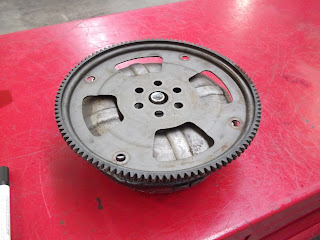The torque converter sits where the clutch would usually sit in a manual transmission. In an automatic transmission, the torque converter does what the clutch does. It releases and engages the engine power to the transmission. It works through pressure of fluid so it is crucial to have fluids healthy in an automatic transmission.
Diagram that I drew of what my understanding is the components of a typical torque converter.
The turbine, stator and impeller are sandwiched inside the torque converter. These components sit in a housing of the torque converter. The turbine and stator are connected to the input shaft of the transmission, and the impeller is connected to the housing, which is bolted to the flexi-plate - the engine crank shaft.
Here we have a torque converter. Unfortunately we haven't got to look inside, the housing is actually welded shut so hopefully it will be cut open on Tuesday when we get to have a look at it again. Inside I am expecting to find a turbine and stator sitting inside, and an impeller connected to the housing of the torque converter. You may also notice that the flexi plate is far lighter than the flywheel. This is because the torque converter itself is heavy enough to keep a momentum.Here is the other side of the torque converter. This is actually not the right flexi-plate for the torque converter but we get the idea. the flexi plate is bolted to the back of the torque converter. Unlike the flywheel of a manual transmission, the torque converter simply slides off the crankshaft. (other wise we wouldn't have access to either side of the flexi-plate).
The automatic transmission I actually found was more interesting than the manual transmission. It works completely differently. The torque converter uses pressures of transmission fluid to transfer the power from the engine to the transmission. the transmission uses a lot of centrifugal forces to operate the system. The centrifugal forces push the fluids to the circumference of the torque converter and since the turbine has fans on it, the turbine absorbs this rotating energy from the fluid being rotated by the impeller. This energy is then transferred to the transmission system. This can be proven with a little experiment I have noticed when a car is on a hoist. If you put a car on a hoist while the engine is running, put it in neutral, the wheels actually start rotating as the engine is spinning this fluid around in the torque converter, but at low pressure.
So the torque converter is like a substitute for a clutch and flywheel. It uses mechanics to transfer the rotating forces of the engine to the transmission through centrifugal forces.




Good comment on the Torque converter, by now you will have seen the cut open example. It's good to build on the knowledge you already have.
ReplyDelete